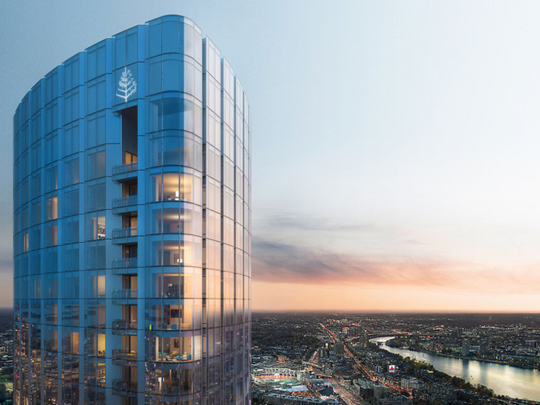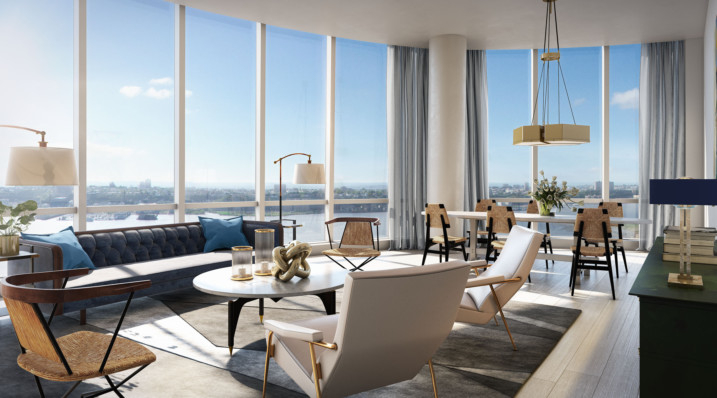
Do you associate top-tier cities in the US East Coast, such as Boston, New York, Philadelphia, Baltimore, Washington and Miami, with only great education institutions? Well, interestingly, besides hosting several Ivy League colleges, these cities now present great opportunities to invest in property as well. There has been an interest in this area from the Middle East, not just from outright property investors, but also from wealthy parents who plan to send their children to top US universities here. Not only do they want their wards to have a proper home to live in during their college years and probably stay on if they want to, they also prefer to have the option to rent the home out or use it as an overseas residence.
Looking at the macro-economic conditions, the time frame may be well chosen to acquire such property now. Over a decade after the 2006 housing market crash in the US, average home prices have recovered almost all their losses, but when adjusted for inflation they are still 20 per cent below the 2006 peak. In the aforementioned mentioned top-tier cities, they seem to be coming closer to fair value when compared with their long-run median prices in the near future.
According to Benjamin Keys, a professor at Wharton School, the business school of Philadelphia-based University of Pennsylvania, a full recovery of house prices is to be expected by 2025, although this depends on location and the further development of interest rates and income growth.
“A few other factors that are correlated include population growth and job growth,” Keys said, indicating that real estate in top-tier cities are expected to play out their full potential the fastest.
Ralph McLaughlin, chief economist of Trulia, one of the largest online residential real estate brokerage firms in the United States, said that the East Coast, along with the West Coast, will be the two areas first to catch up.
“Industries that drive the East Coast continue to be centred on the financial sector, whereas in the West the primary focus is on the technological sector,” McLaughlin noted. “But there is a heavier focus on education in the East with a large concentration of Ivy League institutions on that side of the country. By and large, both of these areas in the US have strong economies and are leaders in terms of economic trends. This means when the country experiences an upswing, both the West and East Coasts will be the first to trend up.”
Focusing on tertiary educational institutions, PW looked at new premium residential developments in three East Coast cities, namely Boston, New York and Miami. They host top varsities such as Harvard University, Massachusetts Institute of Technology, Boston University and nearby Cambridge University (Boston), Columbia University, New York University and Cornell University (New York), as well as the University of Miami and the Florida International University (Miami).
Boston
Boston currently experiences a notable upscale development with the One Dalton Street tower, which will be not just the city’s, but entire New England’s tallest primarily residential tower when completed around the end of next year. The tower, officially named Four Seasons Hotel & Private Residences One Dalton Street and built by Massachusetts-based real estate developer Carpenter & Company, will have 61 floors over a height of 226m and comprise 160 luxury condos on floors 26 to 61, as well as Four Seasons’ 215 hotel rooms on the lower floors.
The tower is marketed by Campion & Company, one of Boston’s boutique real estate agencies. Top units include duplex penthouses and penthouse flats starting from floor 55, of which just a few are left for sale. The top four-bedroom, 678-sq-m units have recently been priced at $40 million each, which made them the most expensive properties in the city, surpassing former records by $5 million.
According to a Carpenter & Company spokesperson, the strengthening property market in Boston can be attributed to an influx of investment in the city from some of the world’s most influential companies, including Amazon, IBM and General Electric, which have all recently relocated or expanded their operations to the city.
Furthermore, it helps that Boston has been ranked number three behind Los Angeles and London and ahead of Chicago and New York in this year’s Schroders Global Cities 30 index, which measures the overall potential of a city based on a range of factors, including the projected growth of the economy, disposable incomes, infrastructure and amenities, education opportunities and population growth over the next decade.
“Boston saw one of the biggest leaps in the index going from 24th place to third place after this year’s methodology included university rankings,” said Hugo Machin, co-head of global real estate securities at Schroders. “Universities are critical in powering city economies, as innovation and education provide a better trained, more productive workforce. Knowledge-based hubs are growing in economic strength with a positive knock-on to real estate markets in those locations, and such strong city economies have the potential to provide superior investment returns.”
New York
From Schroders’ list, New York would be the next city with the highest potential on the East Coast, being ranked fifth. The most populous city in the US held onto its ranking from last year, indicating stability in its economy and investment climate and a healthy and high-yield real estate market.
Among current upscale property developments, there are two that caught PW’s attention. One is the colossal Hudson Yards development, which describes itself as the largest private real estate development in the history of the US and the largest development in New York City since the Rockefeller Centre. It is a huge mixed-use development that will span over 11.3 hectares on Manhattan’s West Side and include more than 1.67 sq km of commercial and residential space, more than 100 shops and a collection of restaurants, as well as offices and residences in six towers named 10, 15, 30, 35, 50 and 55 Hudson Yards. There will be luxury residential units in towers 15, a residential tower with 285 one- to four-bedroom apartments overlooking the Hudson River, and 35, a mixed-use building. Tower 15 rises 88 storeys and is the first condominium opportunity in Hudson Yards. It is expected to be completed next year.
To get an impression of prices in 15 Hudson Yards, penthouse 88B was recently unveiled as the first of the building’s four duplex penthouses that came to market. With a price tag of $32 million (Dh117.53 million), the four-bedroom unit occupies one of the four arcs at the crown of the building and measures 480 sq m.
According to one of 15 Hudson Yards’ brokerages, The Corcoran Group, the tower has sold close to 100 residences since launch in mid-September 2016, outpacing all other new Manhattan residential developments. Sales in the building average nearly $5 million per unit, according to Ryan Schleis, vice-president of research and analytics of The Corcoran Group.
“15 Hudson Yards quickly became one of the fastest-selling buildings of 2016, with more signed contracts than any other new construction development in Manhattan,” says Schleis. “Its sales success is a testament to the deep market for the most exciting properties in New York, such as Hudson Yards’ unique combination of integrated lifestyle, superlative amenities, beautiful architecture and interiors. With an average sale price of nearly $5 million, buyers are responding well to all of the property’s diverse unit sizes, from one to four bedrooms.”
Certainly adding to that lifestyle offer is a rooftop lounge and garden, which will be the highest residential outdoor space in New York City when the tower eventually opens. And, Columbia University is just a 30-minute taxi or subway ride away.
Another new luxury option in New York that also has a unique design feature is the 53W53 tower, a 320m structure rising above the city’s Museum of Modern Art on 53 West 53rd Street in Midtown Manhattan. 53W53 was designed by renowned architect Jean Nouvel and its interiors are courtesy of architect and interior designer Thierry Despont, known for his mastery of exceptional private residences and some of the most luxurious hotels in the world.
The building will comprise of 145 units when completed in 2018, ranging in size from one to five bedrooms, the most exclusive of them being full-floor homes and duplex penthouses with private elevators. Amenities include a wellness centre spanning more than 1,500 sq m, two large vertical gardens framing a large swimming pool, library, theatre and dining lounge for residents overlooking the Central Park. The five lower floors will be an extension of the Museum of Modern Art, so that both structures unite.
According to New York City real estate brokerage Streeteasy, the current price range for a unit in 53W53 spans from around $3.5 million for a smaller condo of around 150 sq m to a full-floor penthouse on the 65th floor with over 599 sq m at $43.95 million, based on current active listings, which show that 67 units have already been sold at an average price of $9.5 million.
Miami
For those who prefer a warmer climate, there is an exclusive option in Florida, The Surf Club Four Seasons Residences, located on the grounds of Miami’s historic Surf Club, which was opened in the 1930s by tire tycoon Harvey Firestone at Surfside on the northern end of Miami beach. The Four Seasons chain decided to bring the iconic member’s club back to life after it shut its doors in 2013 by licensing the development of a new hotel flanked by two elegant 12-storey private residences with 119 apartments. Current active listings of the residences show a price range of between $3.9 million and $29.95 million.
This is likely to revive the chic Dolce Vita-style atmosphere of the Surf Club, which in its heyday has been a refuge for many celebrities, including Frank Sinatra, Elizabeth Taylor, Dean Martin, Marlene Dietrich, Douglas Fairbanks and Winston Churchill, as well as many other wealthy and famous guests, artists and Hollywood stars seeking a short escape to socialise and reload.
“The new Surf Club is an extended embodiment of its original values at a greater scale,” said Nadim Ashi, the founder of Miami-based real estate development firm Fort Partners, which today owns the Surf Club and is also the developer of the residences, using the Four Seasons brand. “We have not created The Surf Club, but we have a commitment to excellence and to ensure that what we are doing has integrity, culture and quality at its heart. It needs to be alive and loved.”
The residences come fully furnished in a creamy French Riviera design style, floor-to-ceiling windows and terraces, private elevator entrances and have easy access to the main hotel’s three pools and landscaped gardens, as well as to a spa and two restaurants. Miami downtown is a 20-minute drive away, while the University of Miami and the Florida International University can each be reached in 40 minutes by car, so prospective students can have the lifestyle their lifetime.













